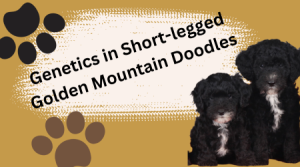
Relatively recent research is helping us understand the genetics behind the short-legged trait seen in some Golden Mountain Doodles
Short-legged dogs, sometimes humorously referred to as “hot dogs,” have earned an enduring place in the dog-breeding world. With an appearance that remains puppy-ish even into adulthood, short-legged canines have endeared themselves to many. Due to the introduction of the short-legged gene in some mini poodle lines, you may find some shorter-legged Golden Mountain Doodles.
Genetics play a crucial role in determining a dog’s leg length. While short-legged dogs historically have been purposely bred for this trait, there are some factors to be aware of if you own (or are considering) a short-legged GMD.
The Role of Genetics in Short-Legged Dogs
Recent research has shed increasing light on the connection between Chondrodysplasia (CDPA), the Canine Chondrodystrophy (CDDY) gene, and the development of short legs in dogs. These genetics affect the growth of long bones in a dog’s legs, resulting in shorter limbs and, typically, a longer body shape. Gene variants have been identified in many short-legged breeds, but in the world of the Golden Mountain Doodle, the mini poodle is the typical source of the short-legged appearance. One study estimates an approximately 60% frequency of CDDY in mini and toy poodles. [1]
Potential Increase of Risk for IVDD in Short-Legged Dogs
Research is now suggesting that short-legged dogs are more susceptible to a condition known as Intervertebral Disc Disease (IVDD), a spinal disorder that can result in pain, paralysis, and, in severe cases, the need for surgical intervention.It is important to note that the presence of the CDDY gene does not “cause” IVDD. Rather, the risk of IVDD merely increases (and only incrementally) in short-legged dogs with certain genetic influences.
Some researchers say that the CDDY gene only increases the risk of developing IVDD by 10-15%. It is noteworthy that 40-75% of all cases of IVDD are identified in the Dachshund breed alone. [2]
Of course, this does not minimize the potential or the effects for short-limbed GMDs, but it does offer some perspective. It is not known whether the short-legged characteristic, and any accompanying risks, in Golden Mountain Doodles would be the same as for other, more established breeds.
What does this mean for breeding practices?
The genetic test for CDDY did not become available to breeders until 2019, and it is not until even more recently that breeders have widely known of the CDDY/IVDD connection and the importance of testing.
In a statement about CDPA and CDDY testing as relates to IVDD, the Goldendoodle Association of North America (GANA) said that “At this time there does not appear to be any association with the CDDY gene and IVDD disease in Goldendoodles.” In other words, IVDD is not yet identified as a significant risk in the general Goldendoodle population. Further, GANA advises breeders not to hastily remove CDDY-affected dogs too abruptly from the breeding program, but rather to take a slow-and-steady approach to eliminating CDDY from the gene pool as much as is possible. [3]
The take-away for short-legged GMD owners
CDDY is not causative in the development of IVDD, although it does present a slightly increased risk of developing IVDD. A concerned owner can implement preventative measures that will contribute to the overall health of a short-legged dog in the long term [4]:
- Regular supplementation (Glucosamine and chondroitin, Omega-3 fatty acids)
- Careful monitoring of a dog’s exercise and play habits, taking care especially not to put undue stress on joints and back with long runs or high jumps and hard landings
- Creating a routine of several shorter exercise/play periods rather than one or two longer sessions
- Weight management, which can reduce strain on the dog’s back
Understanding the genetic and environmental factors influencing short-leggedness in dogs is essential for both breeders and pet owners. By balancing genetic considerations with overall health measures, we can contribute to the betterment of dog breeds like the GMD and promote the long and happy lives of our four-legged friends—especially the shorter-legged ones!

